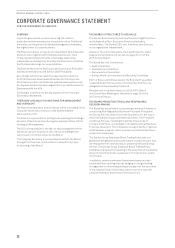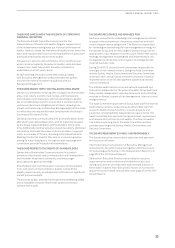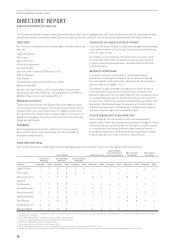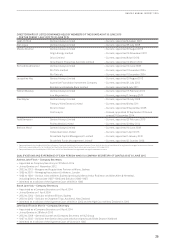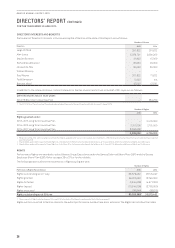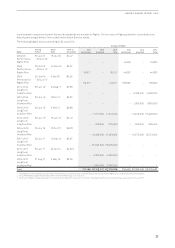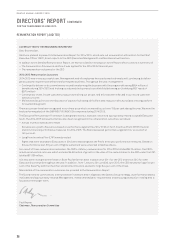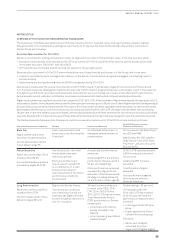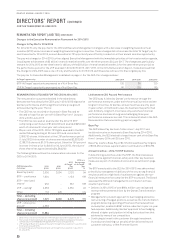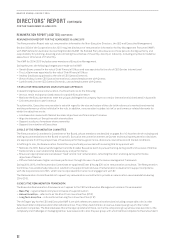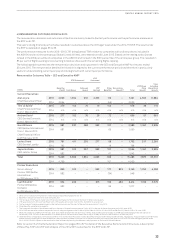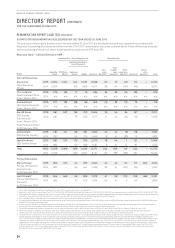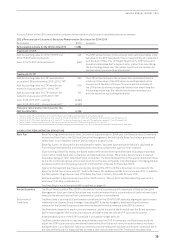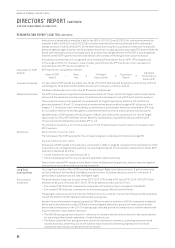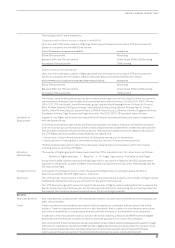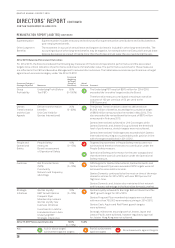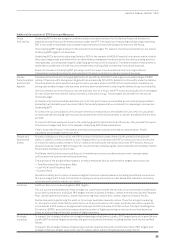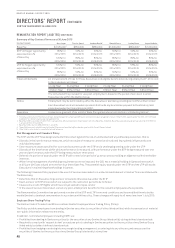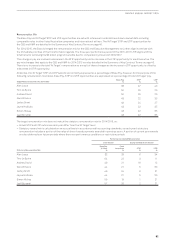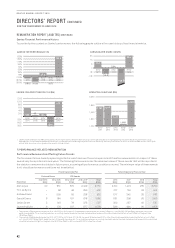Qantas 2015 Annual Report Download - page 33
Download and view the complete annual report
Please find page 33 of the 2015 Qantas annual report below. You can navigate through the pages in the report by either clicking on the pages listed below, or by using the keyword search tool below to find specific information within the annual report.
32
QANTAS ANNUAL REPORT 2015
REMUNERATION REPORT (AUDITED) CONTINUED
REMUNERATION REPORT FOR THE YEAR ENDED 30 JUNE 2015
The Remuneration Report sets out remuneration information for Non-Executive Directors, the CEO and Executive Management.
Section 300A of the Corporations Act 2001 requires disclosure of remuneration information for Key Management Personnel (KMP),
with KMP defined in Australian Accounting Standard AASB 124 Related Party Disclosures as those persons having authority and
responsibility for planning, directing and controlling the activities of the entity, directly or indirectly, including any director (whether
executive or otherwise) of that entity.
The KMP for 2014/2015 includes some members of Executive Management.
During the year, the following changes were made to the KMP:
–Gareth Evans ceased in the role of Chief Financial Officer and was appointed to the role of CEO Qantas International
–Tino La Spina was appointed to the role of Chief Financial Officer
–Andrew David was appointed to the role of CEO Qantas Domestic
–Simon Hickey, former CEO Qantas International, ceased employment with Qantas
–Lyell Strambi, former CEO Qantas Domestic, ceased employment with Qantas
1) EXECUTIVE REMUNERATION OBJECTIVES AND APPROACH
In determining Executive remuneration, the Board aims to do the following:
–Attract, retain and appropriately reward a capable Executive team
–Motivate the Executive team to meet the unique challenges the company faces as a major international airline based in Australia
–Link remuneration to performance
To achieve this, Executive remuneration is set with regard to the size and nature of the role (with reference to market benchmarks)
and the performance of the individual in the role. In addition, remuneration includes ‘at risk’ or performance-related elements for
which the objectives are to:
–Link Executive reward with Qantas’ business objectives and financial performance
–Align the interests of Executives with shareholders
–Support a culture of employee share ownership
–Support the retention of Executives
2) ROLE OF THE REMUNERATION COMMITTEE
The Remuneration Committee (a Committee of the Board, whose members are detailed on pages 8 to 10) has the role of reviewing and
making recommendations to the Board on specific Executive remuneration matters at Qantas and ensuring remuneration decisions
are appropriate from the perspectives of business performance, governance, disclosure, reward levels and market conditions.
In fulfilling its role, the Remuneration Committee is specifically concerned with ensuring that its approach will:
–Motivate the CEO, Executive Management and the broader Executive team to pursue the long-term growth and success of Qantas
–Demonstrate a clear relationship between pay and performance
–Ensure an appropriate balance between ‘fixed’ and ‘at risk’ remuneration, reflecting the short and long-term performance
objectives of Qantas
–Differentiate between higher and lower performers through the use of a performance management framework
During 2014/2015, the Remuneration Committee re-appointed Ernst & Young (EY) as its remuneration consultant. The Remuneration
Committee has established protocols in relation to the appointment and use of remuneration consultants to support compliance
with the Corporations Act 2001, which are incorporated into the terms of engagement with EY.
The Remuneration Committee did not request any remuneration consultants to provide a remuneration recommendation during
2014/2015.
3) EXECUTIVE REMUNERATION FRAMEWORK
The Executive Remuneration Framework as it applies to the CEO and Executive Management contains three elements:
–Base Pay – a guaranteed salary level inclusive of superannuation
–Annual Incentive – referred to as the Short Term Incentive Plan (STIP)
–Long Term Incentive – referred to as the Long Term Incentive Plan (LTIP)
The ‘At Target’ pay for the CEO and Executive KMP is set with reference to external market data including comparable roles in other
listed Australian companies and in international airlines. The primary benchmark is a revenue-based peer group of other listed
Australian companies. The Board believes this is the appropriate benchmark, as it is the comparator group whose roles best mirror the
complexity and challenges in managing Qantas’ businesses and is also the peer group with whom Qantas competes for Executive talent.
DIRECTORS’ REPORT CONTINUED
FOR THE YEAR ENDED 30 JUNE 2015


